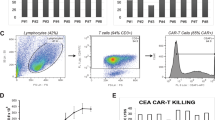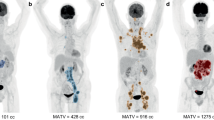Abstract
Our phase I Hepatic Immunotherapy for Metastases (HITM) trial tested the safety of chimeric antigen receptor-modified T-cell (CAR-T) hepatic artery infusions (HAI) for unresectable carcinoembryonic antigen (CEA)+ liver metastases (LM). High neutrophil:lymphocyte ratios (NLR) predict poor outcome in cancer patients and we hypothesized that NLR changes would correlate with early responses to CAR-T HAI. Six patients completed the protocol. Three patients received CAR-T HAI in dose escalation (1 × 108, 1 × 109 and 1 × 1010 cells) and the remainder received three doses (1 × 1010 cells) with interleukin (IL)2 support. Serum cytokines and NLR were measured at multiple time points. The mean NLR for all patients was 13.9 (range 4.8–38.1). NLR increased in four patients following treatment with a mean fold change of 1.9. Serum IL6 levels and NLR fold changes demonstrated a trend towards a positive correlation (r=0.77, P=0.10). Patients with poor CEA responses were significantly more likely to have higher NLR level increases (P=0.048). Increased NLR levels were associated with poor responses following CAR-T HAI. NLR variations and associated cytokine changes may be useful surrogates of response to CAR-T HAI.
This is a preview of subscription content, access via your institution
Access options
Subscribe to this journal
Receive 12 print issues and online access
$259.00 per year
only $21.58 per issue
Buy this article
- Purchase on Springer Link
- Instant access to full article PDF
Prices may be subject to local taxes which are calculated during checkout




Similar content being viewed by others
References
Jemal A, Bray F, Center MM, Ferlay J, Ward E, Forman D . Global cancer statistics. CA Cancer J Clin 2011; 61: 69–90.
Ismaili N . Treatment of colorectal liver metastases. World J Surg Oncol 2011; 9: 154.
Abdalla EK, Vauthey JN, Ellis LM et al. Recurrence and outcomes following hepatic resection, radiofrequency ablation, and combined resection/ablation for colorectal liver metastases. Ann Surg. 2004; 239: 818–825 discussion 825.
Adam R, Wicherts DA, de Haas RJ et al. Patients with initially unresectable colorectal liver metastases: is there a possibility of cure? J Clin Oncol 2009; 27: 1829–1835.
Tomlinson JS, Jarnagin WR, DeMatteo RP et al. Actual 10-year survival after resection of colorectal liver metastases defines cure. J Clin Oncol 2007; 25: 4575–4580.
Falcone A, Ricci S, Brunetti I et al. Phase III trial of infusional fluorouracil, leucovorin, oxaliplatin, and irinotecan (FOLFOXIRI) compared with infusional fluorouracil, leucovorin, and irinotecan (FOLFIRI) as first-line treatment for metastatic colorectal cancer: the Gruppo Oncologico Nord Ovest. J Clin Oncol 2007; 25: 1670–1676.
Rosenberg SA, Restifo NP, Yang JC, Morgan RA, Dudley ME . Adoptive cell transfer: a clinical path to effective cancer immunotherapy. Nat Rev Cancer 2008; 8: 299–308.
Rosenberg SA . Cell transfer immunotherapy for metastatic solid cancer—what clinicians need to know. Nat Rev Clin Oncol 2011; 8: 577–585.
Saied A, Pillarisetty VG, Katz SC . Immunotherapy for solid tumors-a review for surgeons. J Surg Res 2013; 187: 525–535.
Nishino M, Jagannathan JP, Krajewski KM et al. Personalized tumor response assessment in the era of molecular medicine: cancer-specific and therapy-specific response criteria to complement pitfalls of RECIST. AJR Am J Roentgenol 2012; 198: 737–745.
Wolchok JD, Hoos A, O’Day S et al. Guidelines for the evaluation of immune therapy activity in solid tumors: immune-related response criteria. Clin Cancer Res 2009; 15: 7412–7420.
Knupfer H, Preiss R . Serum interleukin-6 levels in colorectal cancer patients—a summary of published results. Int J Colorectal Dis 2010; 25: 135–140.
Okugawa Y, Miki C, Toiyama Y et al. Loss of tumoral expression of soluble IL-6 receptor is associated with disease progression in colorectal cancer. Br J Cancer 2010; 103: 787–795.
Waldner MJ, Foersch S, Neurath MF . Interleukin-6—a key regulator of colorectal cancer development. Int J Biol Sci 2012; 8: 1248–1253.
Ueda T, Shimada E, Urakawa T . Serum levels of cytokines in patients with colorectal cancer: possible involvement of interleukin-6 and interleukin-8 in hematogenous metastasis. J Gastroenterol 1994; 29: 423–429.
Kinoshita T, Ito H, Miki C . Serum interleukin-6 level reflects the tumor proliferative activity in patients with colorectal carcinoma. Cancer 1999; 85: 2526–2531.
de Jong KP, von Geusau BA, Rottier CA et al. Serum response of hepatocyte growth factor, insulin-like growth factor-I, interleukin-6, and acute phase proteins in patients with colorectal liver metastases treated with partial hepatectomy or cryosurgery. J Hepatol 2001; 34: 422–427.
Evrard S, Menetrier-Caux C, Biota C et al. Cytokines pattern after surgical radiofrequency ablation of liver colorectal metastases. Gastroenterol Clin Biol 2007; 31: 141–145.
Hammerich L, Heymann F, Tacke F . Role of IL-17 and Th17 cells in liver diseases. Clin Dev Immunol 2011; 2011: 345803.
Vizio B, Novarino A, Giacobino A et al. Potential plasticity of T regulatory cells in pancreatic carcinoma in relation to disease progression and outcome. Exp Ther Med 2012; 4: 70–78.
Kishi Y, Kopetz S, Chun YS, Palavecino M, Abdalla EK, Vauthey JN . Blood neutrophil-to-lymphocyte ratio predicts survival in patients with colorectal liver metastases treated with systemic chemotherapy. Ann Surg Oncol 2009; 16: 614–622.
Suwa T, Hogg JC, English D, Van Eeden SF . Interleukin-6 induces demargination of intravascular neutrophils and shortens their transit in marrow. Am J Physiol Heart Circ Physiol 2000; 279: H2954–H2960.
Paramanathan A, Saxena A, Morris DL . A systematic review and meta-analysis on the impact of pre-operative neutrophil lymphocyte ratio on long term outcomes after curative intent resection of solid tumours. Surg Oncol 2013; 23: 31–39.
Roxburgh CSD, McMillan DC . Role of systemic inflammatory response in predicting survival in patients with primary operable cancer. Future Oncol 2010; 6: 149–163.
Wang DS, Ren C, Qiu MZ et al. Comparison of the prognostic value of various preoperative inflammation-based factors in patients with stage III gastric cancer. Tumour Biol 2012; 33: 749–756.
Halazun KJ, Aldoori A, Malik HZ et al. Elevated preoperative neutrophil to lymphocyte ratio predicts survival following hepatic resection for colorectal liver metastases. Eur J Surg Oncol 2008; 34: 55–60.
Walsh SR, Cook EJ, Goulder F, Justin TA, Keeling NJ . Neutrophil-lymphocyte ratio as a prognostic factor in colorectal cancer. J Surg Oncol 2005; 91: 181–184.
Katz SC . Hepatic Immunotherapy for Liver Metastases phase I trial. Society of Surgical Oncology 67th Cancer Symposium 2014; 40: 52.
Azab B, Bhatt VR, Phookan J et al. Usefulness of the neutrophil-to-lymphocyte ratio in predicting short-and long-term mortality in breast cancer patients. Ann Surg Oncol 2012; 19: 217–224.
Ding PR, An X, Zhang RX et al. Elevated preoperative neutrophil to lymphocyte ratio predicts risk of recurrence following curative resection for stage IIA colon cancer. Int J Colorectal Dis 2010; 25: 1427–1433.
Lotze MT, Matory YL, Ettinghausen SE et al. In vivo administration of purified human interleukin 2. II. Half life, immunologic effects, and expansion of peripheral lymphoid cells in vivo with recombinant IL 2. J Immunol 1985; 135: 2865–2875.
Neal CP, Mann CD, Sutton CD et al. Evaluation of the prognostic value of systemic inflammation and socioeconomic deprivation in patients with resectable colorectal liver metastases. Eur J Cancer 2009; 45: 56–64.
Hammarstrom S . The carcinoembryonic antigen (CEA) family: structures, suggested functions and expression in normal and malignant tissues. Semin Cancer Biol 1999; 9: 67–81.
Acknowledgements
Financial Support: Support for this work was provided by the National Institute of Health (1K08CA160662-01A1), the Society of Surgical Oncology Clinical Investigator Award supported by an education grant for Genentech, the Rhode Island Foundation and Roger Williams Medical Center Graduate Medical Education Fund.
Author information
Authors and Affiliations
Corresponding author
Ethics declarations
Competing interests
The authors declare no conflict of interest.
Rights and permissions
About this article
Cite this article
Saied, A., Licata, L., Burga, R. et al. Neutrophil:lymphocyte ratios and serum cytokine changes after hepatic artery chimeric antigen receptor-modified T-cell infusions for liver metastases. Cancer Gene Ther 21, 457–462 (2014). https://doi.org/10.1038/cgt.2014.50
Received:
Revised:
Accepted:
Published:
Issue Date:
DOI: https://doi.org/10.1038/cgt.2014.50
This article is cited by
-
HITM-SIR: phase Ib trial of intraarterial chimeric antigen receptor T-cell therapy and selective internal radiation therapy for CEA+ liver metastases
Cancer Gene Therapy (2020)
-
Peripheral immune-based biomarkers in cancer immunotherapy: can we realize their predictive potential?
Journal for ImmunoTherapy of Cancer (2019)
-
First-in-class immune-modulating small molecule Icaritin in advanced hepatocellular carcinoma: preliminary results of safety, durable survival and immune biomarkers
BMC Cancer (2019)
-
Adoptive cell transfer therapy for hepatocellular carcinoma
Frontiers of Medicine (2019)
-
Chimeric antigen receptor T cell (CAR-T) immunotherapy for solid tumors: lessons learned and strategies for moving forward
Journal of Hematology & Oncology (2018)



